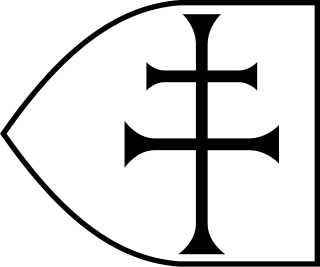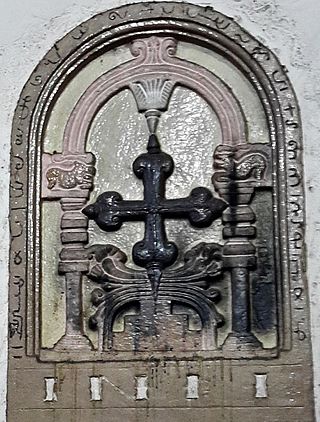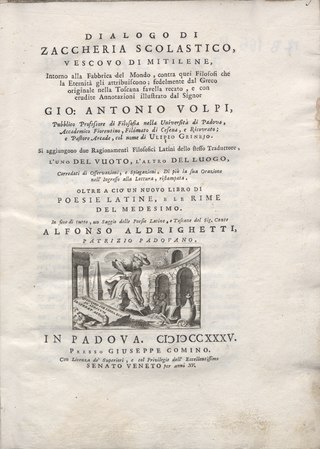Abraham (8th century) was ruler of the Nubian kingdom of Makuria.
According to Severus of El Ashmunein, upon the death of king Simon, Zacharias the son of king Merkurios then appointed Abraham, "a valiant youth attached to the palace" to succeed Simon. 1 However, Abraham proved to be an unsatisfactory ruler, and refused the advice of his mentor, bishop Kyriakos, and in the end sent him with letters "full of false testimonies" to Patriarch Michael I. Patriarch Michael invoked a synod where king Abraham's accusations were read, and Abraham's plea to replace bishop Kyriakos with his own nominee, a man named John.
Despite the outrageousness of king Abraham's claims the synod acquiesced to his demands, but in response to a miraculous event Kyriakos was permitted to return to Makuria, where he settled in a monastery. Severus claims that for the remaining 24 years of the former bishop's life, no rain fell in Makuria, "every year the people were visited by a pestilence, and that those who bore false witness against him were suddenly struck blind". When he learned what had happened, the former king Zacharias deposed Abraham and exiled him to an island in the middle of the Nile, replacing him with Markos.

Year 465 (CDLXV) was a common year starting on Friday of the Julian calendar. At the time, it was known as the Year of the Consulship of Hermenericus and Basiliscus. The denomination 465 for this year has been used since the early medieval period, when the Anno Domini calendar era became the prevalent method in Europe for naming years.
Pope Nicholas I, called Nicholas the Great, was the bishop of Rome and ruler of the Papal States from 24 April 858 until his death. He is remembered as a consolidator of papal authority, exerting decisive influence on the historical development of the papacy and its position among the Christian nations of Western Europe. Nicholas I asserted that the pope should have suzerainty over all Christians, even royalty, in matters of faith and morals.
The Patriarch of Antioch is a traditional title held by the bishop of Antioch. As the traditional "overseer" of the first gentile Christian community, the position has been of prime importance in Pauline Christianity from its earliest period. This diocese is one of the few for which the names of its bishops from the apostolic beginnings have been preserved. Today five churches use the title of patriarch of Antioch: one Eastern Orthodox ; one Oriental Orthodox ; and three Eastern Catholic.

Severus the Great of Antioch, also known as Severus of Gaza or the Crown of Syrians, was the Patriarch of Antioch, and head of the Syriac Orthodox Church, from 512 until his death in 538. He is venerated as a saint in the Oriental Orthodox Church, and his feast day is 8 February.

Makuria was a medieval Nubian kingdom in what is today northern Sudan and southern Egypt. Its capital was Dongola in the fertile Dongola Reach, and the kingdom is sometimes known by the name of its capital.

Michael I was the 46th Coptic Pope and Patriarch of Alexandria from 743 to 767.
Kyriakos or Cyriacus was a ruler of the Nubian kingdom of Makuria. While some authorities place his reign between Merkurios and Zacharias I, according to Severus of El Ashmunein, Kyriakos succeeded Markos.

The Synod of Diamper (Udayamperoor Synod) (Malayalam: ഉദയംപേരൂർ സൂനഹദോസ്, romanized: Udayampērūṟ Sūnahadōs), held at Udayamperoor (known as Diamper in non-vernacular sources) in June 1599, was a diocesan synod, or council, that created rules and regulations for the ancient Saint Thomas Christians (also known as Mar Thoma Nasranis) of the Malabar Coast, a part of modern-day Kerala state, India, formally subjugating them and downgrading their whole Metropolitanate of India as the Diocese of Angamale, a suffragan see to the Archdiocese of Goa administered by Latin Church Padroado missionaries. This synod also introduced forced Liturgical Latinisation and the eschewal of local practices and beliefs, leading to a significant ecclesial protest by Saint Thomas Christians known as Coonan Cross Oath and a subsequent schism in the mid-17th century.
Zacharias I was a ruler of the Nubian kingdom of Makuria.
Simon was ruler of the Nubian kingdom of Makuria.
Markos was ruler of the Nubian kingdom of Makuria. According to Severus of El Ashmunein, Markos ruled for only six months.1
Athanasius II Baldoyo, also known as Athanasius of Balad, and Athanasius of Nisibis, was the Patriarch of Antioch and head of the Syriac Orthodox Church from 684 until his death in 687.
Saint Ephraim of Antioch, also known as Saint Ephraim of Amida, was the Patriarch of Antioch, and head of the Greek Orthodox Church of Antioch, from 527 until his death in 545. He is venerated as a saint in the Eastern Orthodox and Catholic Churches. His feast day is 8 June.
Ignatius Isaac II was the Patriarch of Antioch and head of the Syriac Orthodox Church from 1709 until his resignation in 1723.
Quriaqos of Tagrit was the Patriarch of Antioch, and head of the Syriac Orthodox Church, from 793 until his death in 817. He is commemorated as a saint by the Syriac Orthodox Church in the Martyrology of Rabban Sliba, and his feast day is 13 or 16 August.
Paul II the Black, also known as Paul of Bēth Ukkāme, was the Patriarch of Antioch and head of the Syriac Orthodox Church from c. 551 or 564 to his deposition in 578. He succeeded Sergius of Tella as the spiritual leader of the Syrian non-Chalcedonians, in opposition to the Chalcedonian Imperial Church, and led the nascent Syriac Orthodox Church as it endured division and persecution.

Zacharias of Mytilene, also known as Zacharias Scholasticus or Zacharias Rhetor, was a bishop and ecclesiastical historian.

Metropolitanate of India was an East Syriac ecclesiastical province of the Church of the East, at least nominally, from the seventh to the sixteenth century. The Malabar region (Kerala) of India had long been home to a thriving Eastern Christian community, known as the Saint Thomas Christians. The community traces its origins to the evangelical activity of Thomas the Apostle in the 1st century. The Christian communities in India used the East Syriac Rite, the traditional liturgical rite of the Church of the East. They also adopted some aspects of Dyophysitism of Theodore of Mopsuestia, often inaccurately referred as Nestorianism, in accordance with theology of the Church of the East. It is unclear when the relation between Saint Thomas Christian and the Church of the East was established. Initially, they belonged to the metropolitan province of Fars, but were detached from that province in the 7th century, and again in the 8th, and given their own metropolitan bishop.
Iwannis I was the Patriarch of Antioch and head of the Syriac Orthodox Church from 739/740 until his death in 754/755.
Ignatius II was the Patriarch of Antioch and head of the Syriac Orthodox Church from 878 until his death in 883.